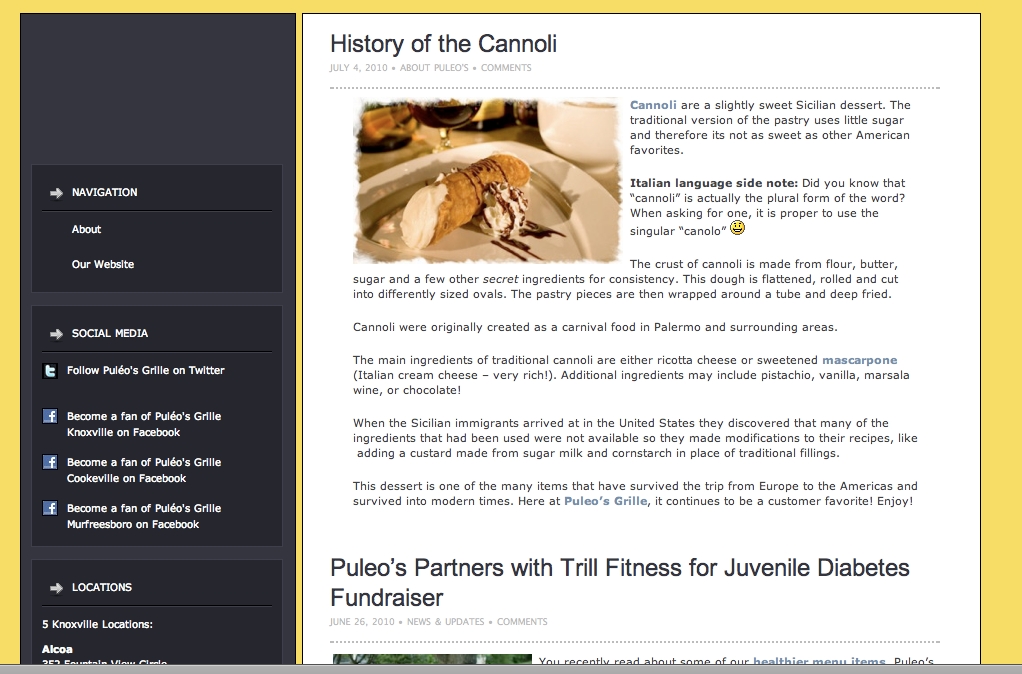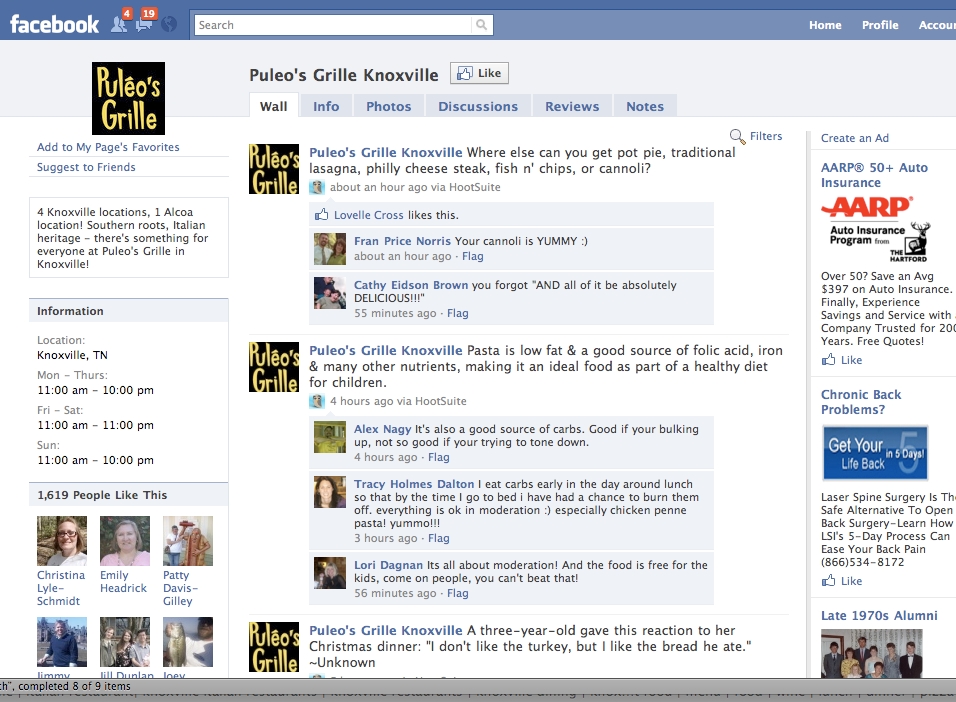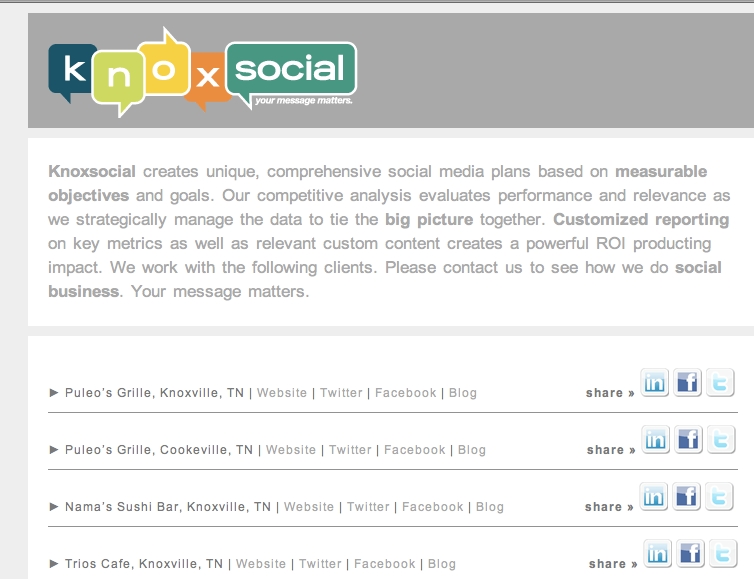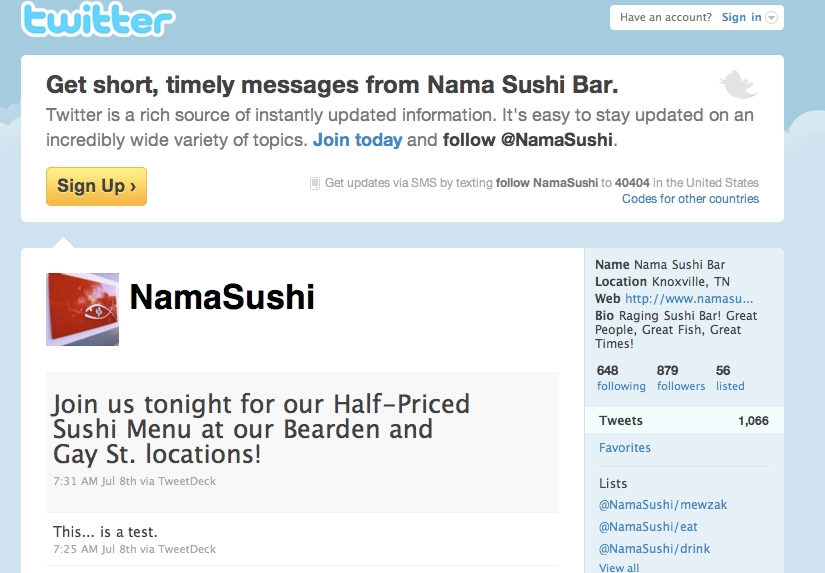Knoxsocial: How to sell Facebook services
Site: Knoxnews.com, the site of the Knoxville News Sentinel
Company: Scripps Newspaper Group
Key executive: Jay Horton, Director of Advertising
Summary: Knoxnews.com's sales team knew a number of their advertisers were interested in social media and decided to hold a seminar for them on creating Facebook fan pages. At the end of the seminar, the businesses were still interested but said "I just don't have time to watch it " or " I'm afraid someone might say something bad about my business and I won't see it." The team wanted to come up with a way to sell a service their clients obviously wanted, and also to make profit doing it. The new social media service they created is profitable and growing, with 16 new clients at an average of $1000 per month. All advertisers upgraded or are buying premium media. A Power Point sample presentation is attached at the bottom of this article.
Challenge: Create a profitable inhouse social media division to serve a growing demand, while making a profit within six months.
Strategy: Auditing the staff to find "champions" is the start of this strategy. Ad director Jay Horton had one person on the sales team with strong social media skills to help put together the new program. They named the venture KnoxSocial, and registered knoxsocial.com. The team decided the new services would provide local businesses with several social media products:
• A weekly blog on the advertiser's site, but hosted on the Knoxsocial.com platform.
• Facebook fan page creation and strategy to build a base of fans.
• Facebook updates including customer testimonials, discounts, contests, new services and products and blog headlines. The service also includes monitoring posts and keep up with discussions.
• Facebook targeted ad campaigns to support discounts, contests or other themes intended to build fans and increase business. Once tested on Facebook, offers are often supported through other media buys.
• Updating Twitter feeds with the new offers and specials.
• Creation of Youtube videos to support marketing objectives of various kinds.
Finally, part of the service is a monthly meeting to talk about what is going on the with the fan page and other strategies, collect customer testimonials, and discuss You Tube videos.
The initial set up meeting can take hours of intensive questioning.
"We ask how do they market, what's been successful. We are also diving into who their customer are and why they are buying, when the store is busy or slow, and what are the favorite products. The success of everything depends on how much we know about what they are doing," Horton says.
To get a Fan Page launched, use coupons or other offers in exchange for customers signing up as fans. KnoxSocial charges an initial set up fee, then prices each piece of the social media service separately on a cost plus mark-up basis based on the time allotted. The average package Horton says is just under $1000 a month.
The sales executive handles the deal-making component and maintains the relationship with the account and its employees. "The sales representatives have to sell it, but they don't have to manage it. Their job is the 10,000 foot level," Horton says "The specialist comes in and does the deeper dive and manages the process."
The specialists are two social media editors hired to monitor the social media, stay in tune with customer's deeper needs and hire freelancers who make the actual blog and Facebook posts. Who to hire? Horton suggests social media experts with ad agency background, who are also personally heavy social media users.
"Part of the interview process was taking a business that is either real or made-up and building a social media marketing plan."
"We only engage accounts we feel we can work with and have the bandwidth to do. We have to know we have a blogger who will jell well with what the customer is looking for in terms of the voice of the business."
To streamline the process Horton recommends using project management software such as Basecamp, so that all the people working on the project can share information. "The system continues to get better and faster."
Horton says he expects to have 12 to 20 accounts in each zip code area and that he anticipates handling 30 accounts per FTE.
Results: So far the Facebook targeting campaigns are delivering good results for advertisers. One restaurant with a two week ad campaign for a "buy one, get one free" breakfast entre had 300 click throughs, 30 coupons redeemed and a jump in their fan base. This particular account did not want to use in-store promos, so the campaign targeted geographically relevant people, linked back to the fan page as a splash page, and asked visitor to "like them" to retrieve the coupon.
Horton says KnoxSocial overall is already profitable after six months, with 16 customers at the average monthly price of "just under" $1000 mostly for blogs and Facebook updates. The number of clients has doubled since April. At least 2/3 of these businesses were not consistent advertisers before and others were sporadic advertisers. The relationship has opened up new doorways in other ways.
"Its been an eye opening experience," Horton says. "Just about every account we have is now using some other advertising service with us. The reward at the end of the day is you get to know your customer better, what works, which messages drive the best result. That learning makes display advertising and everything else you do more effective." Horton says the best results for clients have come from combining ad placement and management of the page.
Scripps Newspapers and scripps.com are planning to roll out the initiative to all newspaper sites, starting with two in Florida, one in Memhpis and one in Ventura.
Lessons learned:
1. "This is not a part time job. If you want to go there this is a much more in-depth relationship than we get when we sell someone a display ad. You have to know that the investment (in the relationship) has its own benefits. You have to start there."
2. "I didn't know the space so hired someone to do it. That was key."
3. Facebook sales strengthens customer relationship exponentially. "I started my work in reatil sale and prided myself on relationships. But this way of working is ten times stornger."
4. The difference between Facebook and Twitter is that Twitter is a "public conversation and easier to insert yourself into" where people are gathering and talking. "it's easier to say 'come here becase we have this goin on'. A cafe tweeting a special at the beginning of the world cup gets responses right away."

The author, Alisa Cromer is publisher of a variety of online media, including LocalMediaInsider and MediaExecsTech, developed while on a fellowship with the Reynolds Journalism Institute and which has evolved into a leading marketing company for media technology start-ups. In 2017 she founded Worldstir.com, an online magazine, to showcases perspectives from around the world on new topic each month, translated from and to the top five languages in the world.













